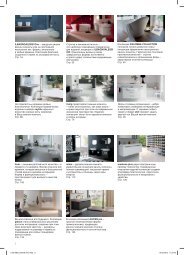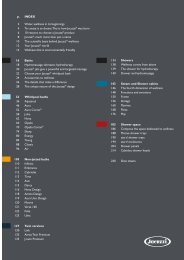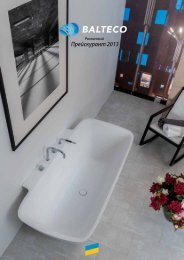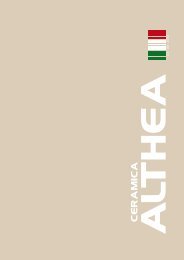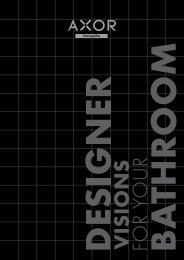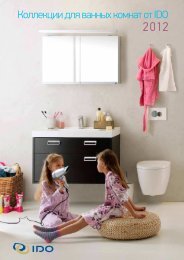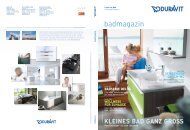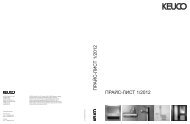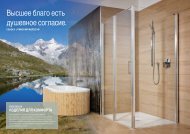You also want an ePaper? Increase the reach of your titles
YUMPU automatically turns print PDFs into web optimized ePapers that Google loves.
USE RECOMMENDED GROUTS - EUROpEAN STANDARDS EN 13888<br />
Residential interiors Improved cementitious mortars for joints (Class CG2 - EN 13888)<br />
Damp interiors (bathrooms, showers, swimming pools, …) and outdoors<br />
Commercial premises<br />
Premises requiring total hygiene and resistance to chemical agents (kitchen work surfaces, food industry, hospitals,<br />
supermarkets, etc).<br />
TESTinG oF THE TilEd SURFACE<br />
The testing of the tiled surface must be done by the final customer in the presence of the installer or the foreman responsible for the works and consists of a visual examination (naked eye<br />
and/or with glasses if normally worn) of the surface from a distance of 1 meter.<br />
An “effect” which is only visible close-up or with grazing light, perhaps with the use of a magnifying glass cannot be considered a “defect”.<br />
An “effect” becomes a “defect” only when clearly visible under the conditions stated above.<br />
ClEAninG AFTER inSTAllATion<br />
The cleaning of the entire flooring after installation is of vital importance for all subsequent maintenance procedures.<br />
Cleaning eliminates residues as well as dirt such as cement, glue, paint and other kinds of dirt, etc.<br />
Once the grout has aged properly, the cleaning using a suitable detergent can begin, but must be carried out in strict accordance of the instructions of use and dilution percentages stated<br />
by the manufacturer of the detergent.<br />
a) Ceramiche <strong>Marca</strong> <strong>Corona</strong> recommends FILA DETERDEk (or any other equivalent buffered non organic acid cleaner, with the exclusion of hydrofluoric acid) for the removal of<br />
cementitious grout residues. Follow instructions below:<br />
• Use FILA DETERDEK diluted 1:5 (1 litre FILA DETERDEK in 5 litres of hot water, result: 1litre/40Sq meter);<br />
• Sweep the floor accurately, and wet the grout joints with water to protect them from the corrosive action of the acid;<br />
• Sweep the floor and then spread the diluted acid solution evenly using a scrubbing-brush, a mop or a rough cloth for residential floors, while larger surfaces should be cleaned using a<br />
single-brush equipped with white or green buffering disks (depending on the necessity);<br />
• Leave the detergent to act for a few minutes depending on the amount and type of dirt;<br />
• Use an abrasive sponge such as a white or green scotch-brite or a scrubbing-brush with nylon bristles for textured surfaces, or, in the case of large surfaces with a single-brush equipped<br />
with green disks and liquid suction capability;<br />
• Collect any residue using a cloth or the liquid suction equipment;<br />
• Rinse with lukeworm or hot water repeating the operation more than once until complete elimination of any rim or dirt residue present on the cavities of textured tiles.<br />
Should some areas of the floor remain dirty, repeat the acid washing with a higher concentration of cleaner.<br />
Improved cementitious mortars for joints with low water absorption (Class CG2 W - EN 13888) obtained with the addition of a<br />
suitable liquid additive<br />
Improved cementitious mortars for joints with high resistance to abrasion (Class CG2 Ar - EN 13888) obtained with the addition of<br />
a suitable liquid additive<br />
Epoxy mortars (Class RG - EN 13888)<br />
wARninG<br />
This procedure can be aggressive towards materials and objects placed close to the tiled surface; for example doors and window sills made of marble, metallic shutters, decors, etc.; it is<br />
advisable to protect these materials before proceeding with the cleaning.<br />
b) For the removal of epoxy grout residues it is absolutely necessary to follow carefully the indication of the cleaner manufacturer, as this can be particularly challenging. <strong>Marca</strong> <strong>Corona</strong><br />
recommends warm water and 10% of alcohol or, as an alternative, an alkaline cleaner like FILA PS/87 (or equivalent). PS/87 should be applied not diluted on the floor, and let act for<br />
about 30 minutes. Then scrub the floor with an abrasive brush and rinse with abundant water.<br />
SpECiFiC inSTRUCTionS:<br />
c) For Polished, Semi-Polished and Metallic porcelain any acid cleaner should be tested on a small area, before cleaning the entire floor.<br />
d) Textured porcelain, or products with high anti-slippery characteristics may be cleaned several times, utilizing increasing concentrations of detergent and a more abrasive brush, as this<br />
type of products may retain more dirt and grout residues. Proper cleaning will restore the original beauty of the product and its anti-slippery characteristics.<br />
e) Matte finish products (non-polished) should not be sealed. If not properly removed, an excess of sealer could actually cause the floor to retain dirt faster.<br />
f) For used floors, before performing any acid cleaning, it is important to remove all the organic residues (grease and similar) with an alkaline detergent, like FILA PS/87 or equivalent.<br />
251



